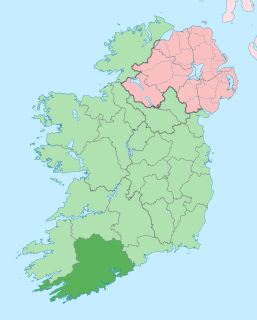| Miners' Way and Historical Trail | |
|---|---|
| Length | 118 km (73 mi) [1] |
| Location | Counties Leitrim, Roscommon & Sligo, Ireland |
| Designation | National Waymarked Trail [1] |
| Trailheads | Arigna |
| Use | Hiking |
| Elevation | |
| Elevation gain/loss | 2,340 m (7,677 ft) [1] |
| Hiking details | |
| Season | Any |
The Miners' Way and Historical Trail is a long-distance trail in Ireland. It is a 118-kilometre (73-mile) long circular route that begins and ends in Arigna, County Roscommon. It is typically completed in five days. [1] It is designated as a National Waymarked Trail by the National Trails Office of the Irish Sports Council and is managed by Roscommon Integrated Development Company, Roscommon County Council, Leitrim County Council and Sligo County Council. [2] The trail was developed to encourage tourism in the area in the wake of the closure of the Arigna mines in 1990. [3] The route was originally conceived by a local priest, Father Sean Tynan, and built with funding from the European Regional Development Fund. [4] The trail was opened by broadcaster Donncha Ó Dúlaing in July 2000. [4]

A long-distance trail is a longer recreational trail mainly through rural areas used for hiking, backpacking, cycling, horse riding or cross-country skiing. They exist on all continents except Antartica.

Ireland, also known as the Republic of Ireland, is a country in north-western Europe occupying 26 of 32 counties of the island of Ireland. The capital and largest city is Dublin, which is located on the eastern side of the island. Around a third of the country's population of 4.8 million people resides in the greater Dublin area. The sovereign state shares its only land border with Northern Ireland, a part of the United Kingdom. It is otherwise surrounded by the Atlantic Ocean, with the Celtic Sea to the south, St George's Channel to the south-east, and the Irish Sea to the east. It is a unitary, parliamentary republic. The legislature, the Oireachtas, consists of a lower house, Dáil Éireann, an upper house, Seanad Éireann, and an elected President who serves as the largely ceremonial head of state, but with some important powers and duties. The head of government is the Taoiseach, who is elected by the Dáil and appointed by the President; the Taoiseach in turn appoints other government ministers.

Arigna is a village in County Roscommon, Ireland. It is near Lough Allen, on a designated "scenic route" between Keadue and Sliabh an Iarainn. Arigna is situated in Kilronan Parish alongside the fellow picturesque villages of Keadue and Ballyfarnon. The village lies close to the shores of Lough Allen.
Contents
The trail consists of three looped routes that travel through neighbouring parts of Counties Roscommon, Leitrim and Sligo. The Miners' Way is 62 kilometres (39 miles) long and follows paths used by miners working in the Arigna coal mines and makes a circuit via Keadue, Ballyfarnon and Corrie Mountain. [5] The Historical Trail is 56 kilometres (35 miles) long and makes a circuit of Lough Key and Lough Arrow via Keadue, Lough Key Forest Park, Boyle, Carrowkeel, Castlebaldwin, Highwood and Ballyfarnon. [5] A third trail makes a circuit of Lough Allen via Drumkeeran, Dowra and Drumshanbo. [5]

County Leitrim is a county in the Republic of Ireland. It is in the province of Connacht and is part of the Border Region. It is named after the village of Leitrim. Leitrim County Council is the local authority for the county, which had a population of 32,044 according to the 2016 census. The county encompasses the historic Gaelic territory of West Breffny (Bréifne) corresponding to the northern part of the county, and Muintir Eolais or Conmaicne Réin, corresponding to the southern part.

County Sligo is a county in Ireland. It is located in the Border Region and is part of the province of Connacht. Sligo is the administrative capital and largest town in the county. Sligo County Council is the local authority for the county. The population of the county is 65,535 according to the 2016 census, making it the 3rd most populated county in the province. It is noted for Benbulben Mountain, one of Ireland’s most distinctive natural landmarks.

Keadue, officially Keadew, is a village in County Roscommon, Ireland. It is on the R284 and R285 regional roads close to the borders of County Leitrim and County Sligo.
Parts of the Miners' Way and Historical Trail also form part of the Beara-Breifne Way, a walking and cycling route under development, intended to run from the Beara Peninsula, County Cork to Breifne, County Leitrim following the line of Donal Cam O'Sullivan Beare's march in the aftermath of the Battle of Kinsale in 1602. [6]

The Beara-Breifne Way is a long distance walking and cycling trail being developed from the Beara Peninsula in County Cork, Ireland, to Blacklion in the area of Breifne in County Cavan. The trail follows closely the line of the historical march of O’Sullivan Beare.

Beara or the Beara Peninsula is a peninsula on the south-west coast of Ireland, bounded between the Kenmare "river" to the north side and Bantry Bay to the south. It contains two mountain ranges running down its centre: the Caha Mountains and the Slieve Miskish Mountains. The northern part of the peninsula from Kenmare to near Ardgroom is in County Kerry, while the rest forms the barony of Bear in County Cork.

County Cork is a county in Ireland. It is the largest and southernmost county of Ireland, situated in the province of Munster and named after the city of Cork, Ireland's second-largest city. The Cork County Council is the local authority for the county. Its largest market towns are Mallow, Macroom, Midleton, and Skibbereen. In 2016, the county's population was 542,868, making it the third-most populous county in Ireland. Notable Corkonians include Michael Collins, Jack Lynch, and Sonia O'Sullivan.





